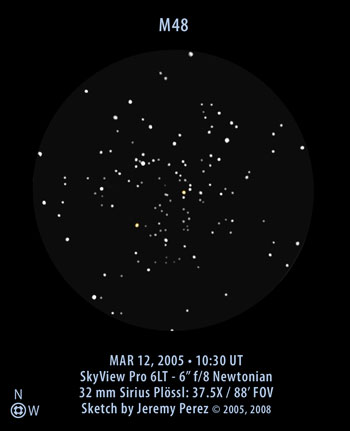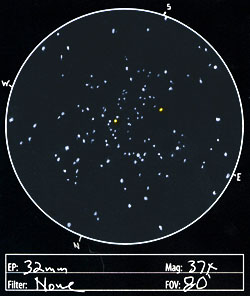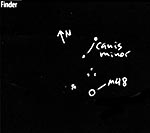
Click image for larger version.
The above sketch is an update to the original to clean it up and remove the color cast. The original is shown below.

Observation Notes:
 M48 was a beautiful open cluster bounded by a distinct arc of stars. My first impression was of a field of bright blue stars. I didn’t notice any background granularity. The middle region appeared hollow. I’d put the dimensions of the main body of the cluster at 20′ with a broader extension extending out to around 45′. It was nice and circular. Besides the tight arc of stars on the northwest side, a wide, bright chain of stars flowed across the southeast side. Together, they give the impression of a lower-case ‘d’.
M48 was a beautiful open cluster bounded by a distinct arc of stars. My first impression was of a field of bright blue stars. I didn’t notice any background granularity. The middle region appeared hollow. I’d put the dimensions of the main body of the cluster at 20′ with a broader extension extending out to around 45′. It was nice and circular. Besides the tight arc of stars on the northwest side, a wide, bright chain of stars flowed across the southeast side. Together, they give the impression of a lower-case ‘d’.
Within the main body of the cluster, I noticed 2 yellow stars as noted in the sketch. I would put 105 of the 137 stars in my sketch to be within the extended body of the cluster–57 of them being in the central region–since the cluster is estimated to have around 80 member stars, several of these must be foreground or background stars. The cluster was easy to find, south of Canis Minor. In this area, a triangle of stars lies to the west and a small cluster of stars to the east. M48 was between and south of these asterisms. M48 itself was visible to the naked eye.
Object Information:
M48 is a conspicuous open cluster that is visible to the naked eye under good conditions. The cluster contains at least 80 stars, with a condensed inner core extending 30′ and outskirts that reach to 54′ in diameter. At a distance of 1500 light years, this corresponds to a diameter of 23 light years. Its age is estimated at 300 million years and contains 3 yellow giant stars of spectral class G-K. The cluster was discovered and catalogued by Charles Messier in 1771. Due to an error in his position data however, the cluster was independently rediscovered by Johann Elert Bode around 1782 and then by Caroline Herschel in 1783. The correct identity of Messier’s discovery was established by Oswald Thomas in 1934 and independently by T.F. Morris in 1959.
| Subject | M48 (NGC 2548) |
| Classification | Open Cluster (Type f) |
| Position* | Hydra [RA: 8:13.8 / Dec: -5:48] |
| Size* | 54′ |
| Brightness* | 5.5 |
| Date/Time | March 11, 2005 – 10:30 PM (March 12, 2005 – 05:30 UT) |
| Observing Loc. | Flagstaff, AZ – US Naval Observatory |
| Instrument | Orion SVP 6LT Reflector (150 mm dia./1200 mm F/L) |
| Eyepieces/Mag. | 32 mm (37X) |
| Conditions | Clear, 35°F |
| Seeing | 6/10 |
| Transparency | Mag 6.3 NELM |
| Sources | SEDS |
*Based on published data.